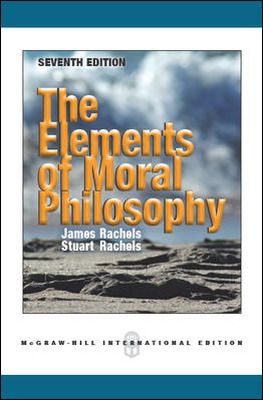EBOOK: The Elements of Moral Philosophy
- Access the eBook anytime, anywhere: online or offline
- Create notes, flashcards and make annotations while you study
- Full searchable content: quickly find the answers you are looking for
Preface
About the Seventh Edition
1. WHAT IS MORALITY?
1.1. The Problem of Definition
1.2. First Example: Baby Theresa
1.3. Second Example: Jodie and Mary
1.4. Third Example: Tracy Latimer
1.5. Reason and Impartiality
1.6. The Minimum Conception of Morality
2. THE CHALLENGE OF CULTURAL RELATIVISM
2.1. Different Cultures Have Different Moral Codes
2.2. Cultural Relativism
2.3. The Cultural Differences Argument
2.4. What Follows from Cultural Relativism
2.5. Why There Is Less Disagreement Than It Seems
2.6. Some Values are Shared by All Cultures
2.7. Judging a Cultural Practice to Be Undesirable
2.8. Back to the Five Claims
2.9. What We Can Learn from Cultural Relativism
3. SUBJECTIVISM IN ETHICS
3.1. The Basic Idea of Ethical Subjectivism
3.2. The Evolution of the Theory
3.3. The First Stage: Simple Subjectivism
3.4. The Second Stage: Emotivism
3.5. The Role of Reason in Ethics
3.6. Are There Proofs in Ethics?
3.7. The Question of Homosexuality
4. DOES MORALITY DEPEND ON RELIGION?
4.1. The Presumed Connection between Morality and Religion
4.2. The Divine Command Theory
4.3. The Theory of Natural Law
4.4. Religion and Particular Moral Issues
5. ETHICAL EGOISM
5.1. Is There a Duty to Help the Starving?
5.2. Psychological Egoism
5.3. Three Arguments for Ethical Egoism
5.4. Three Arguments against Ethical Egoism
6. THE SOCIAL CONTRACT THEORY
6.1. Hobbes’s Argument
6.2. The Prisoner’s Dilemma
6.3. Some Advantages of the Social Contract Theory
6.4. The Problem of Civil Disobedience
6.5. Difficulties for the Theory
7. THE UTILITARIAN APPROACH
7.1. The Revolution in Ethics
7.2. First Example: Euthanasia
7.3. Second Example: Marijuana
7.4. Third Example: Nonhuman Animals
8. THE DEBATE OVER UTILITARIANISM
8.1. The Classical Version of the Theory
8.2. Is Pleasure All That Matters?
8.3. Are Consequences All That Matter?
8.4. Should We Be Equally Concerned for Everyone?
8.5. The Defense of Utilitarianism
8.6. Concluding Thoughts
9. ARE THERE ABSOLUTE MORAL RULES?
9.1. Harry Truman and Elizabeth Anscombe
9.2. The Categorical Imperative
9.3. Kant's Arguments on Lying
9.4. Conflicts between Rules
9.5. Kant's Insight
10. KANT AND RESPECT FOR PERSONS
10.1. Kant's Core Ideas
10.2. Retribution and Utility in the Theory of Punishment
10.3. Kant's Retributivism
11. FEMINISM AND THE ETHICS OF CARE
11.1. Do Women and Men Think Differently about Ethics?
11.2. Implications for Moral Judgment
11.3. Implications for Ethical Theory
12. VIRTUE ETHICS
12.1. The Ethics of Virtue and the Ethics of Right Action
12.2. The Virtues
12.3. Two Advantages of Virtue Ethics
12.4 Virtue and Conduct
12.5. The Problem of Incompleteness
12.6. Conclusion
13. WHAT WOULD A SATISFACTORY MORAL THEORY BE LIKE?
13.1. Morality without Hubris
13.2. Treating People as They Deserve
13.3. A Variety of Motives
13.4. Multiple-Strategies Utilitarianism
13.5. The Moral Community
13.6. Justice and Fairness
13.7. Conclusion
Notes on Sources
Index
McGraw Hill Connect is an award-winning digital teaching and learning solution that empowers students to achieve better outcomes and enables instructors to improve course management efficiency.
High-Quality Course Material
Our trusted solutions are designed to help students actively engage in course content and develop critical higher-level thinking skills while offering you the flexibility to tailor your course to the ways you teach and the ways your students learn.
Assignments & Automatic Grading
Connect features a question bank that you can select from to create homework, practice tests and quizzes. Dramatically reduce the amount of time you spend reviewing homework and grading quizzes, freeing up your valuable time to spend on teaching.
Analytics & Reporting
Monitor progress and improve focus with Connect’s visual and actionable dashboards. Reports are available to empower both instructors and students with real-time performance analytics.
Seamless Integration
Link your Learning Management with Connect for single sign-on and gradebook synchronization, with all-in-one ease for you and your students.


